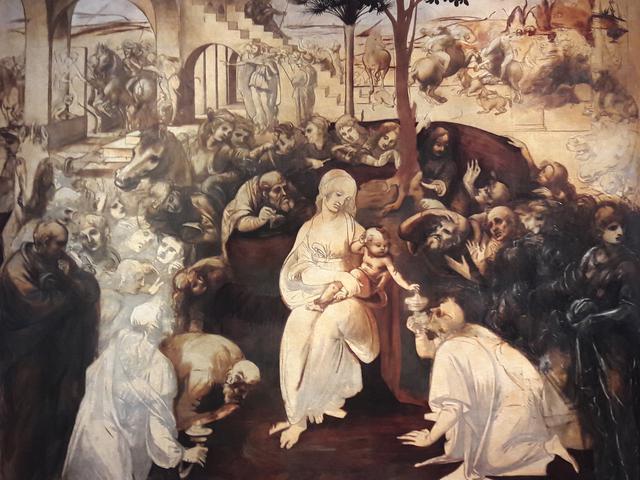Adoration of the Three Wise Men San Donato in Scopeto

A document from July 1481 states that Leonardo da Vinci had received a commission from Augustinian monks to paint a panel for the high altar in the church of San Donato in Scopeto, outside the city walls of Florence. The painting, which Leonardo promised to finish within 30 months, had as its theme the Adoration of the Magi, that is, the celebration of the feast of the Epiphany when, according to Saint Augustine, all people respond to the call of Christ. For this subject, Leonardo studied an extremely complex composition, rich in figures, arranged in a semicircle, with the Virgin and Child as the focus. In the foreground, the kneeling Magi offer their gifts of gold, frankincense and myrrh to Jesus. Leonardo has painted a background with ruined buildings and clashes between knights on horseback, while on the left we can see works on a building, perhaps a temple, in the foreground, two flights of stairs, like the presbytery of several medieval churches (St. Miniato al Monte in Florence, for example). The temple, which alludes to peace, contrasts with the discomfort of the horses fighting on the other side. In September 1481, Leonardo was still working on the painting, but later left Florence to go to the court of Ludovico Sforza in Milan, interrupting the painting he was producing for the church of San Donato in Scopeto. The Augustinian friars waited in vain for the artist to return and complete his painting, until they decided to commission another altarpiece with the Adoration of the Magi by Filippino Lippi, which was completed in 1496. Leonardo's Adoration of the Magi is therefore , a painting that is suspended in execution at an initial level of a sketch. Leonardo took the development of the work to different stages: some of the characters are barely drawn, while others, as if to capture an idea, are more finished. The sky consists of a base layer of white lead and lapis lazuli.
© Tourblink